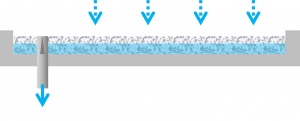Difference between revisions of "Blue roofs"
Jenny Hill (talk | contribs) m |
Jenny Hill (talk | contribs) m |
||
| Line 1: | Line 1: | ||
[[File:Blue roof concept.jpg|thumb|Schematic of flow control valve type blue roof/ rooftop detention]] | [[File:Blue roof concept.jpg|thumb|Schematic of flow control valve type blue roof/ rooftop detention]] | ||
| + | ==Overview== | ||
| + | Blue roofs, or rooftop detention is a popular stormwater management option for many developments. The appeal is the relatively low cost and simplicity of modelling and forecasting performance. | ||
{{textbox|Blue roofs are ideal for: | {{textbox|Blue roofs are ideal for: | ||
| Line 5: | Line 7: | ||
*Zero-lot line projects with outdoor amenity requirements}} | *Zero-lot line projects with outdoor amenity requirements}} | ||
| − | The Ministry of Transportation do not permit blue roofs to form part of a SWM plan owing to concerns over long term maintenance; this affects relatively few projects<ref>Ontario Ministry of Transportation. (2016). Stormwater Management Requirements for Land Development Proposals. Retrieved March 7, 2018, from http://www.mto.gov.on.ca/english/publications/drainage/stormwater/section8.shtml#controls</ref>. The concerns arise from instances where building operators have found outlet control structures blocked with leaves or other debris. Without understanding the purpose of the device, these have been removed to prevent recurrence of the blockage. A study in New York City found that a modular system of trays outperformed an outlet flow control device in stormwater management<ref>Bloomberg, M., & Strickland, C. H. (2012). NYC Green Infrastructure Plan: 2012 Green Infrastructure Pilot Monitoring Report. New York. Retrieved from http://www.nyc.gov/html/dep/pdf/green_infrastructure/2012_green_infrastructure_pilot_monitoring_report.pdf</ref>. It might reasonably be expected that a modular system would present fewer opportunities for complete failure from a single action, either through clogging or breakage of an storage element. | + | ==Types of blue roof== |
| + | Water can be slowed in running from a flat roof (up to 2%) through the use of: | ||
| + | *drain covers (most common), | ||
| + | *small check dams or weirs across the roof deck, or | ||
| + | *modular tray systems. | ||
| + | The Ministry of Transportation do not currently permit blue roofs to form part of a SWM plan owing to concerns over long term maintenance; this affects relatively few projects<ref>Ontario Ministry of Transportation. (2016). Stormwater Management Requirements for Land Development Proposals. Retrieved March 7, 2018, from http://www.mto.gov.on.ca/english/publications/drainage/stormwater/section8.shtml#controls</ref>. The concerns arise from instances where building operators have found outlet control structures blocked with leaves or other debris. Without understanding the purpose of the device, these have been removed to prevent recurrence of the blockage. A study in New York City found that a modular system of trays outperformed an outlet flow control device in stormwater management<ref>Bloomberg, M., & Strickland, C. H. (2012). NYC Green Infrastructure Plan: 2012 Green Infrastructure Pilot Monitoring Report. New York. Retrieved from http://www.nyc.gov/html/dep/pdf/green_infrastructure/2012_green_infrastructure_pilot_monitoring_report.pdf</ref>. It might reasonably be expected that a modular system would present fewer opportunities for complete failure from a single action, either through clogging or breakage of an storage element. | ||
==Resources to review== | ==Resources to review== | ||
Revision as of 19:37, 7 March 2018
Overview[edit]
Blue roofs, or rooftop detention is a popular stormwater management option for many developments. The appeal is the relatively low cost and simplicity of modelling and forecasting performance.
Blue roofs are ideal for:
- Sites without significant space at ground level for infiltration,
- Zero-lot line projects with outdoor amenity requirements
Types of blue roof[edit]
Water can be slowed in running from a flat roof (up to 2%) through the use of:
- drain covers (most common),
- small check dams or weirs across the roof deck, or
- modular tray systems.
The Ministry of Transportation do not currently permit blue roofs to form part of a SWM plan owing to concerns over long term maintenance; this affects relatively few projects[1]. The concerns arise from instances where building operators have found outlet control structures blocked with leaves or other debris. Without understanding the purpose of the device, these have been removed to prevent recurrence of the blockage. A study in New York City found that a modular system of trays outperformed an outlet flow control device in stormwater management[2]. It might reasonably be expected that a modular system would present fewer opportunities for complete failure from a single action, either through clogging or breakage of an storage element.
Resources to review[edit]
Providers[edit]
In our effort to make this guide as functional as possible, we have decided to include proprietary systems and links to manufacturers websites.
Inclusion of such links does not constitute endorsement by the Sustainable Technologies Evaluation Program.
Lists are ordered alphabetically; link updates are welcomed using the form below.
Flow control devices[edit]
Other[edit]
These products are designed to suspend green roof (or other) systems above a layer of free water for the detention period.
- ↑ Ontario Ministry of Transportation. (2016). Stormwater Management Requirements for Land Development Proposals. Retrieved March 7, 2018, from http://www.mto.gov.on.ca/english/publications/drainage/stormwater/section8.shtml#controls
- ↑ Bloomberg, M., & Strickland, C. H. (2012). NYC Green Infrastructure Plan: 2012 Green Infrastructure Pilot Monitoring Report. New York. Retrieved from http://www.nyc.gov/html/dep/pdf/green_infrastructure/2012_green_infrastructure_pilot_monitoring_report.pdf
- ↑ Richard Hammond (2017). Evaluating Green and Blue Roof Opportunities in Canadian Cities. UWSpace. http://hdl.handle.net/10012/11463
- ↑ https://www.pwdplanreview.org/manual/chapter-4/4.6-blue-roofs
